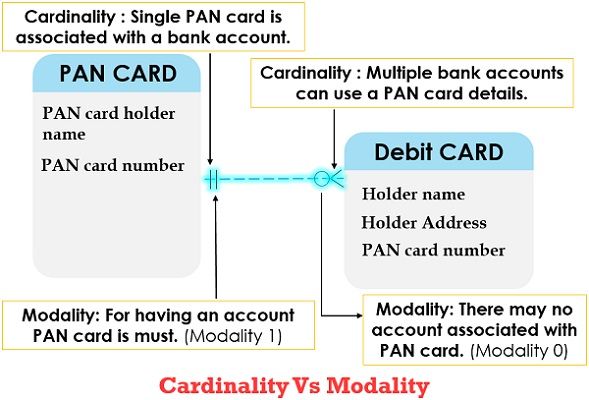 Cardinality and Modality are the two data modelling concepts used for understanding the information domain of the problem. For analysing the data objects, data attributes and relationships structures, the terms given above are very important.
Cardinality and Modality are the two data modelling concepts used for understanding the information domain of the problem. For analysing the data objects, data attributes and relationships structures, the terms given above are very important.
The major difference between cardinality and modality is that the cardinality is defined as the metric used to specify the number of occurrences of one object related to the number of occurrences of another object. On the contrary, modality signifies whether a certain data object must participate in the relationship or not.
Content: Cardinality and Modality
Comparison Chart
| Basis for comparison | Cardinality | Modality |
|---|---|---|
| Basic | Maximum number of associations between the table rows. | Minimum number of row associations. |
| Types | One-to-one, one-to-many, many-to-many. | Nullable and not nullable. |
Definition of Cardinality
Cardinality describes that a data model must be able to represent the number of occurrences of an object/s in a given relationship. It can be expressed in the pattern of “one” or “many”. In database designing, we usually define a group of objects and represent the object/relationship pairs that bind them. Assuming a simple pair – Object “a” related to object “b” does not provide sufficient information for software engineering purposes. So, to interpret how many occurrences of one object is related to how many occurrences of other objects the cardinality is devised.
Let’s take an example of a bank account having the tables PAN card and debit cardholder, each individual can have a unique PAN card number and on the basis of it, that person could own a single (i.e., one-to-one) or several different accounts in different banks (i.e., one-to-many). For associating two objects, any of the three relations can be made.
- One-to-one – In this relation, the occurrence of object “x” can relate to only one occurrence of object “y” and vice-versa.
- One-to-many – One occurrence of object “x” can relate to multiple occurrences of the object “y”. However, the object “y” can only relate to a single occurrence of “x”.
- Many-to-many – Multiple occurrences of object “x” can relate to multiple occurrences of object “y” and vice-versa.
Definition of Modality
The Modality is completely different from the cardinality. Its value is computed as “o” when there is no requirement for the relationship to occur or if the relationship is optional. The modality value is “1” if there is a compulsion for the occurrence of a relationship. In simple words, it describes whether a relationship between two or more entities is even required or not.
Let’s take an example of a PAN card and its related debit cardholders. In the Debit card holder table, there will be a PAN card number, which makes a link to the PAN card holder as a bank account holder necessarily required to have a PAN card. Now, if the modality is in this example is “0” then there present a row without PAN card number but if it is “1” then we should have a value in the PAN card number.
So, here if the modality is “0” or more then “0” which specifies the Debit cardholder does not have any PAN card number hence is not needed to be held. Debit card holder table not only maintains the active cardholder data but also the data of users which have closed their bank accounts and this is called NULLABLE column due to its acceptance of an empty field.
When the modality is 1, the debit cardholder must be having a PAN card number, which means a bank account with no PAN card number cannot be included in the table. Therefore this column is considered to be NOT NULL column as it does not accept null values.
Key Differences Between Cardinality and Modality
- Cardinality is nothing but the maximum number of objects that can participate in a relationship. In contrast, modality is the possibility of making relations between objects.
- There can be three cases possible in cardinality – one-to-one, one-to-many and many-to-many. As against, the modality of the given relationship can be nullable or non-nullable.
Example
Conclusion
The cardinality and modality are the concepts mainly used while designing a database and holds great importance. The cardinality describes the number of relations an object possesses for another object. On the other hand, modality describes whether the relation is required to be made or not.

Leave a Reply